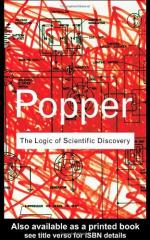|
This section contains 864 words (approx. 3 pages at 400 words per page) |

|
Part II: Chapter 10, Corroboration, or How a Theory Stands up to Tests Summary and Analysis
The central question for Popper is how a theory stands up to tests. Popper finds that traditional inductivists working in probabilistic logic and seeking to determine how probable a hypothesis is do not ask the right questions. He equates this issue to the confusion between psychological and logical questions. His goal is to see if a theory is corroborated, and to what degree, by its ability to survive rigorous tests.
The scientific theory arguments he uses to underpin his explorations are these. Theories are not verifiable. They are not falsifiable, either, as far as their logical form is concerned. Showing that a result of the theory or a prediction is verified does not make the theory itself verifiable. Old...
(read more from the Part II: Chapter 10, Corroboration, or How a Theory Stands up to Tests Summary)
|
This section contains 864 words (approx. 3 pages at 400 words per page) |

|




